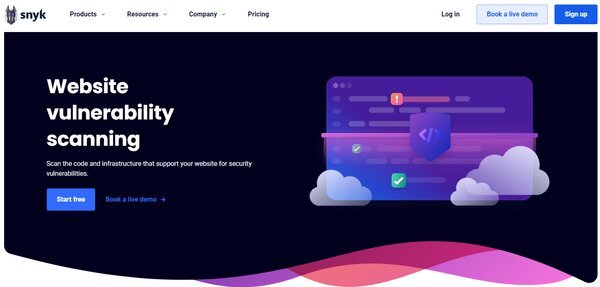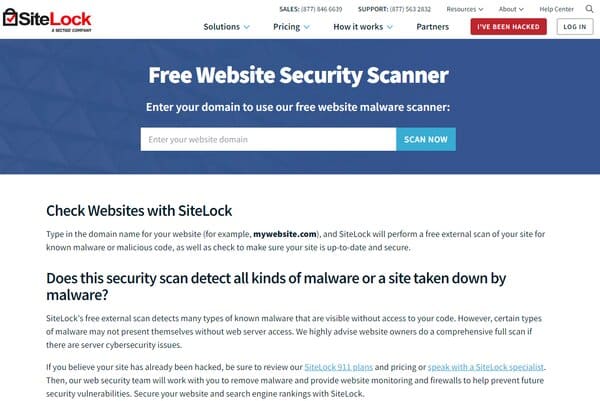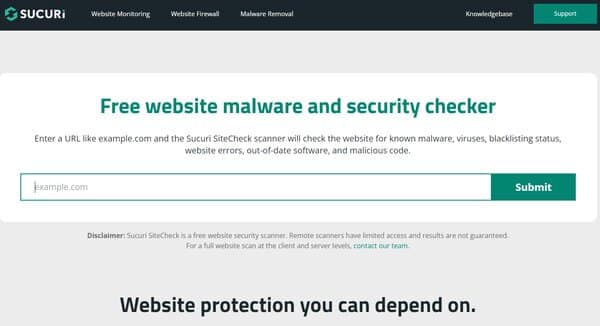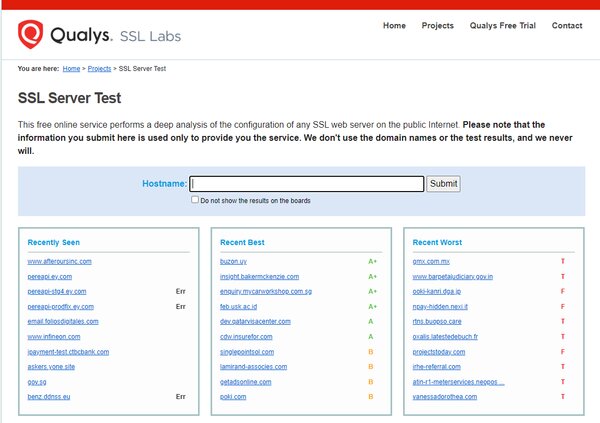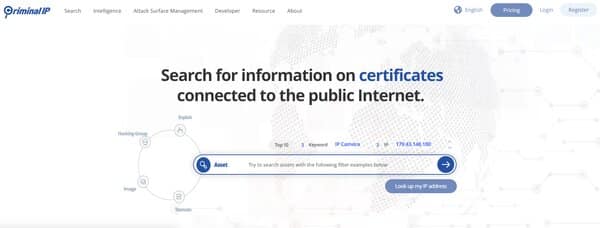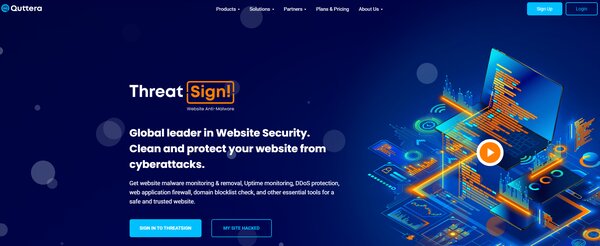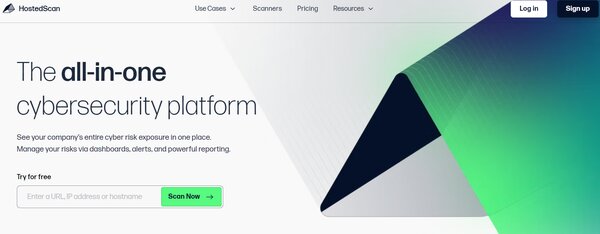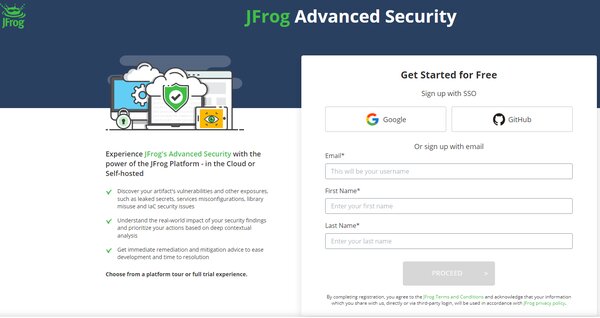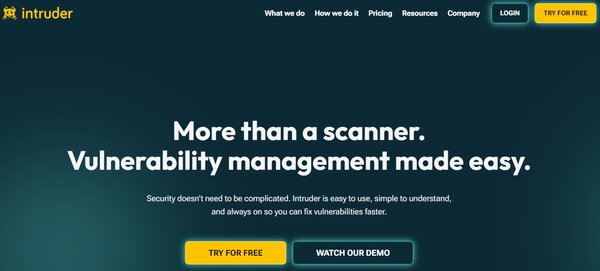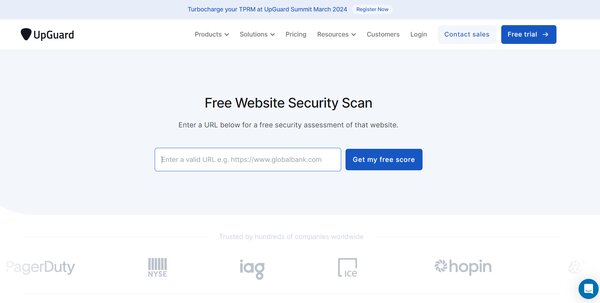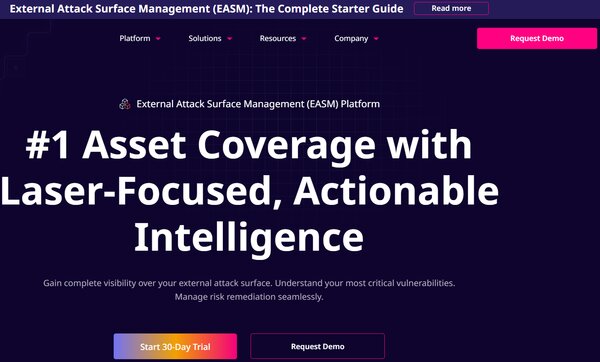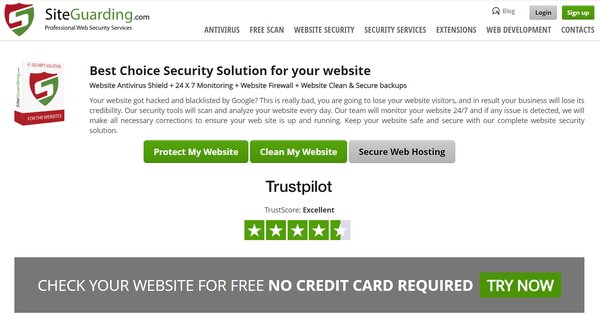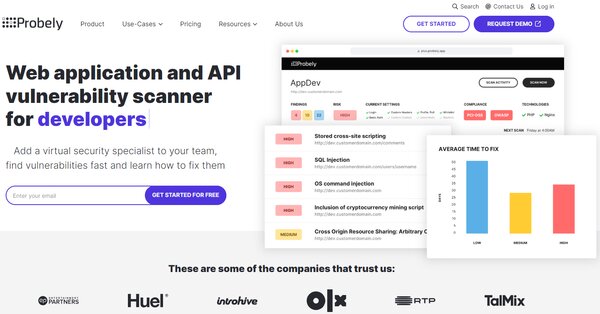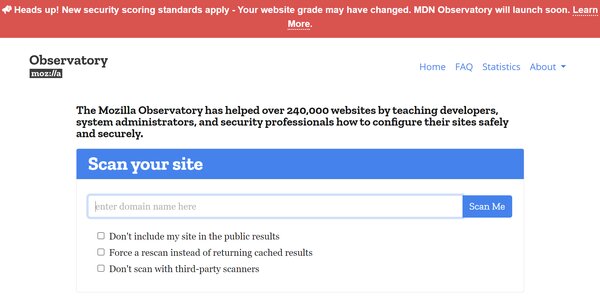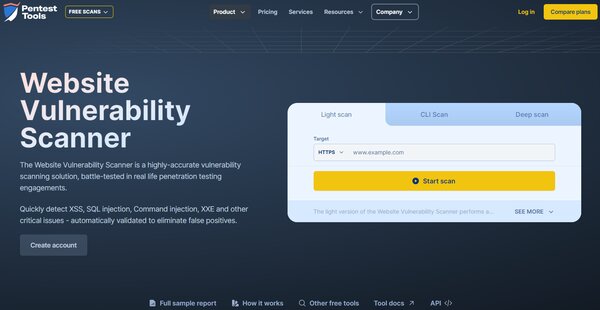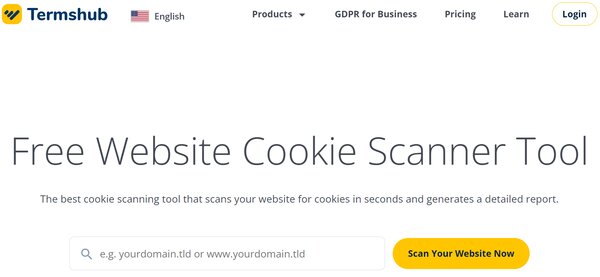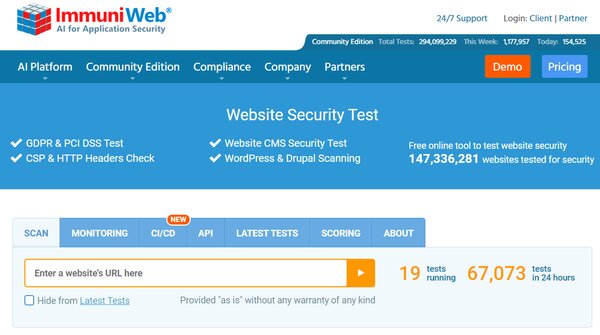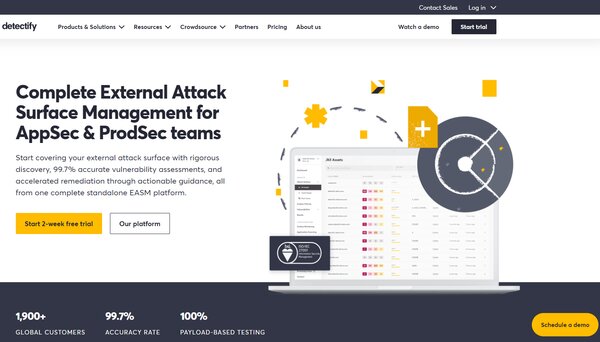18 Best Check Website Security Online
Check Website Security Online
Ensuring the security of a website is a critical aspect of maintaining an online presence. Whether you’re running a personal blog or a large e-commerce platform, the importance of safeguarding your site against cyber threats cannot be overstated. With the rise of sophisticated hacking techniques, it’s essential to utilize tools and practices that can effectively shield your digital assets from unauthorized access and potential harm. If you want to check website security online, keep on reading to discover the 18 best check website security online, facts, use cases, key features, and to select the most suitable check website security online for you.
The Need for Check Website Security Online
The digital landscape is fraught with risks that can compromise the integrity of websites. Cybercriminals are constantly on the lookout for vulnerabilities to exploit, making it imperative for website owners to stay vigilant. A single breach can lead to significant financial losses, damage to reputation, and erosion of customer trust. This is where the need to check website security online comes into play.
Website security checks are comprehensive evaluations that scrutinize various aspects of a website to identify potential security gaps. These checks encompass scanning for malware, assessing the site for vulnerabilities like SQL injection or cross-site scripting (XSS), and ensuring that the website is not blacklisted by search engines due to suspicious activities. By conducting regular security checks, website owners can detect issues early and take corrective measures before attackers can cause harm.
Moreover, website security is not just about protecting your own data, it’s also about safeguarding the information of your users. With regulations like the General Data Protection Regulation (GDPR) imposing strict rules on data protection, failing to secure your website can lead to legal repercussions and hefty fines.
Check Website Security Online
To address these concerns, a variety of online tools and services have been developed to help website owners check and enhance their site’s security. These tools can scan for known vulnerabilities, check for software updates, and monitor for ongoing attacks. Some even offer automated patching and response capabilities, reducing the time and technical expertise required to maintain a secure online presence.
The need to check website security online is undeniable in today’s internet-driven world. By proactively managing the security of your website, you not only protect your business but also contribute to a safer internet ecosystem for everyone. Remember, the cost of prevention is always less than the cost of recovery after a security breach.
18 Best Check Website Security Online
- Snyk
- SiteLock
- SUCURI
- Qualys
- Criminal IP
- Quttera
- HostedScan Security
- JFrog Security
- Intruder
- UpGuard
- Attaxion
- SiteGuarding
- Probely
- Observatory
- Pentest-Tools
- Web Cookies Scanner
- ImmuniWeb
- Detectify
How does Check Website Security Online work?
Check website security online functions by scanning websites for vulnerabilities and malware. These checks are essential for identifying potential security threats that could compromise the integrity and safety of a website. The process involves using automated tools that remotely assess a site for issues such as outdated software, malicious code injections, and other security risks. These tools can quickly evaluate a website without the need for installing any software or plugins, making the process convenient and efficient.
Once a scan is initiated, the tool checks the website against various databases and criteria, including blocklists for known malicious sites and checks for outdated or vulnerable software. It also scans the website’s code to detect any malware or suspicious scripts. After the scan, these tools often provide a report detailing the findings, including identified vulnerabilities and recommendations for remediation. This allows website owners to take proactive steps to secure their sites, such as updating software, removing malicious code, and implementing stronger security measures.
How to choose an Check Website Security Online?
Choosing the right online website security check tool involves considering several factors to ensure comprehensive protection for your website. The effectiveness of a security check tool depends on its ability to accurately identify vulnerabilities and provide actionable insights for remediation. When selecting a tool, consider its reputation and reliability. Opt for tools that are well-regarded in the cybersecurity community and have a proven track record of identifying a wide range of security issues.
Another important factor is the depth of the scan. The tool should be capable of performing both surface-level scans for common vulnerabilities and more in-depth analyses that can uncover hidden issues within the website’s code or server configuration. This ensures a thorough assessment of the website’s security posture.
The tool’s ease of use and accessibility are also crucial. It should offer a user-friendly interface that allows you to easily initiate scans and understand the reports generated. Additionally, consider whether the tool provides actionable recommendations for fixing identified vulnerabilities, as this guidance is invaluable for effectively securing your website.
Finally, consider the tool’s update frequency. Cybersecurity threats evolve rapidly, so it’s important that the tool is regularly updated to detect the latest vulnerabilities and malware. A tool that is frequently updated can provide more accurate and relevant security assessments, helping to keep your website safe from emerging threats.
In summary, when choosing an online website security check tool, prioritize reputation, scanning depth, ease of use, actionable recommendations, and update frequency to ensure comprehensive protection for your website.
Check Website Security
1. Snyk
Snyk is a cutting-edge platform designed to enhance the security of websites by meticulously scanning both the code and infrastructure for vulnerabilities and check website security online. It addresses the critical need for vulnerability management in web applications, interactive, and static websites, which are frequent targets for cyber threats. By offering a straightforward three-step process that includes creating an account, importing a project, and reviewing scan results, Snyk simplifies the task of identifying and rectifying security issues. This approach not only aids in protecting proprietary code across various web ecosystems but also automates the process of applying necessary fixes, thereby streamlining vulnerability management.
What does Snyk do?
Snyk operates as a comprehensive security tool that empowers developers to identify and automatically rectify vulnerabilities in their code, dependencies, containers, and infrastructure as code (IaC). It supports a wide array of programming languages and integrates seamlessly into development tools, pipelines, and workflows, making it an indispensable asset for modern DevSecOps practices. By offering a free tier with generous limits for open-source, container, and IaC tests, Snyk makes security accessible to developers at all levels. Its ability to integrate with a variety of source control platforms, container registries, cloud providers, and continuous integration tools further enhances its utility, making it a versatile solution for securing cloud-native applications throughout the software development lifecycle.
Snyk Key Features
Automated Vulnerability Fixes: Snyk stands out by automating the process of fixing vulnerabilities. Once a security issue is identified, Snyk generates a pull request with the necessary upgrades and patches, simplifying the remediation process for developers.
Developer-First Approach: The platform is designed with developers in mind, integrating directly into IDEs, repositories, and workflows. This ensures that security is a seamless part of the development process, rather than an afterthought.
Comprehensive Vulnerability Database: Snyk’s Vulnerability Database is a treasure trove of security intelligence, offering advanced insights to help fix both open-source and container vulnerabilities effectively.
Support for Multiple Languages and Frameworks: Catering to a wide range of web ecosystems, Snyk provides support for popular programming languages such as JavaScript, Python, and PHP, making it a versatile tool for developers.
Integration Capabilities: Snyk boasts extensive integration options with source control platforms, container registries, cloud providers, and CI tools, enabling a smooth incorporation into existing development environments and workflows.
Infrastructure as Code (IaC) Security: Recognizing the shift towards IaC, Snyk offers specialized scanning capabilities to prevent misconfigurations and ensure the security of infrastructure code, further broadening its application scope.
Open-Source Security: By scanning open-source dependencies for vulnerabilities, Snyk helps maintain the security integrity of applications that rely on open-source software, providing peace of mind for developers and organizations alike.
2. SiteLock
SiteLock offers a suite of comprehensive cybersecurity services designed to protect websites from a myriad of online threats enabling to check website security online. As a cloud-based security solution, it specializes in scanning websites for malware, vulnerabilities, and other potential security risks. SiteLock not only identifies these threats but also provides tools and services to fix and prevent them, ensuring that websites remain secure and operational. Its services cater to a wide range of users, from small personal blogs to large e-commerce platforms, making it a versatile option for website owners looking to safeguard their online presence.
What does SiteLock do?
SiteLock serves as a vigilant protector for websites, continuously scanning for and identifying malware, vulnerabilities, and other cyber threats. It operates by performing daily scans of a website’s code and database, alerting website owners to any issues that arise. In the event of a detected threat, SiteLock can automatically remove the malicious content, patch vulnerabilities, and even restore the website from backups if necessary. Its proactive approach to web security ensures that threats are dealt with swiftly, minimizing the risk of damage to the website and its visitors. Additionally, SiteLock’s services extend to include a web application firewall (WAF) and a content delivery network (CDN), which work together to enhance website performance and protect against more sophisticated cyber attacks.
SiteLock Key Features
Daily Malware Scanning: SiteLock performs regular scans of websites from the outside-in, detecting malware that could harm the site or its visitors.
Automated Malware Removal: Upon detection of malicious content, SiteLock can automatically remove it, ensuring the safety of the website and its users.
Web Application Firewall (WAF): This feature protects websites against advanced cyber threats, including the top ten threats that could damage a site.
Content Delivery Network (CDN): SiteLock’s CDN accelerates website speed, which can improve search engine optimization (SEO) and enhance user experience.
Vulnerability Patching: The service includes a vulnerability scanner that checks for weaknesses in a website’s content management system (CMS) before they can be exploited by hackers.
Website Backup: SiteLock provides secure backup solutions for websites, protecting against ransomware, hardware corruption, and human errors.
SiteLock Trust Seal: Websites that are secure and malware-free can display the SiteLock Trust Seal, which has been shown to increase trust and conversion rates.
Risk Score Assessment: Leveraging various variables, SiteLock provides a risk assessment to help website owners understand their vulnerabilities and how to mitigate them.
Expert Support: Access to SiteLock’s team of security experts is available for guidance and assistance in managing web security issues.
3. SUCURI
SUCURI is a comprehensive check website security online tool designed to enhance website security through meticulous scanning and monitoring services. It offers a free website security scanner that checks for known malware, viruses, blacklisting status, website errors, out-of-date software, and malicious code. While the remote scanner provides a quick assessment, SUCURI also emphasizes the importance of a full website scan at both client and server levels for a thorough security check. This service is particularly valuable for webmasters seeking to protect their sites from potential threats and maintain a clean, secure online presence. SUCURI’s approach to website security is backed by a team of highly technical security professionals distributed globally, ensuring that the tool stays updated with the latest in cybersecurity threats and solutions.
What does SUCURI do?
SUCURI serves as a guardian for websites by offering a suite of security services aimed at detecting and preventing online threats. It scans websites for malware, blacklisting, outdated CMS, vulnerable plugins, and extensions, and provides security recommendations. Beyond scanning, SUCURI actively removes malware and assists in the recovery of hacked sites, ensuring that webmasters can regain control and restore their online reputation swiftly. The tool’s ability to detect malicious code and infected file locations by scanning the external website source code is crucial for maintaining a healthy website. Additionally, SUCURI monitors websites for security anomalies and configuration issues, offering regular checks that help webmasters stay ahead of potential security breaches. This proactive approach to website security is designed to offer peace of mind to website owners, knowing their sites are monitored and protected against the evolving landscape of cyber threats.
SUCURI Key Features
Malware Removal and Hack Repair: SUCURI excels in identifying and cleaning up malware infections, offering a rapid response to hacking incidents to minimize damage and restore website integrity.
Blacklist Monitoring: It keeps a vigilant eye on the website’s reputation by checking if it’s blacklisted by major security authorities, ensuring traffic and SEO rankings are not adversely affected.
Outdated Software Detection: SUCURI identifies outdated CMS, plugins, and extensions, which are common vulnerabilities exploited by attackers, and provides recommendations for updates to strengthen security.
Security Anomaly Detection: The tool scans for unusual activities and configuration issues, offering insights into potential security risks and how to mitigate them.
Regular Security Monitoring: With continuous surveillance, SUCURI ensures that websites are consistently checked for malware and other security threats, offering webmasters peace of mind.
Global Security Team: Backed by a team of security professionals around the world, SUCURI’s expertise in the cybersecurity domain is unparalleled, ensuring that the tool is always equipped with the latest in threat detection and mitigation techniques.
Website Speed Optimization: Through its content delivery network (CDN), SUCURI not only secures websites but also improves their loading speed, enhancing user experience and SEO.
4. Qualys
Qualys is a cloud-based security and compliance solution that assists businesses in identifying and mitigating vulnerabilities across a wide range of IT assets including checking website security online. It provides a suite of tools for continuous monitoring, vulnerability management, policy compliance, and web application scanning, among others. Qualys is designed to help organizations simplify their IT security operations and reduce the cost of compliance by delivering critical security insights and automating various aspects of the IT security process.
What does Qualys do?
Qualys offers a robust platform for securing IT infrastructures and web applications. It continuously scans and identifies vulnerabilities within networked assets, including servers, network devices, and endpoints. The platform is capable of managing both internet-exposed and internal vulnerabilities, providing a comprehensive view of an organization’s security posture. Qualys also offers compliance reporting, leveraging a vast knowledge base mapped to industry standards and frameworks. Its Software-as-a-Service (SaaS) model allows for easy access from any web browser, enabling organizations to manage security exposures without the resource and deployment issues associated with traditional software.
Qualys Key Features
Automated Crawling and Testing: Qualys Web Application Scanning (WAS) automates the process of crawling and testing custom web applications, ensuring regular testing that produces consistent results and reduces false positives.
Vulnerability Management: The Qualys VM service provides immediate visibility into potential vulnerabilities across IT systems, helping organizations secure their infrastructure and comply with regulations.
Policy Compliance: Qualys Policy Compliance (PC) automates security configuration assessments on IT systems, aiding in risk reduction and continuous compliance with internal and external policies.
Continuous Monitoring: Qualys Continuous Monitoring (CM) allows organizations to identify threats and monitor changes within internet-facing devices, providing immediate notifications to IT staff when changes occur.
PCI Compliance: Qualys PCI Compliance simplifies the process of achieving compliance with the Payment Card Industry Data Security Standard (PCI DSS), offering a cost-effective and highly automated solution for businesses and online merchants.
Cloud Agent Technology: Qualys’ cloud agents can be installed on various devices to continuously assess security and compliance in real-time, providing a dynamic approach to vulnerability management.
Scalable SaaS Platform: The platform’s cloud-based nature allows for scalability, enabling Qualys to grow with an organization’s needs by adding more capacity for scanning, analysis, and reporting.
5. Criminal IP
Criminal IP is a Cyber Threat Intelligence (CTI) search engine that offers a unique approach to enhancing cybersecurity measures for individuals and organizations alike. By scanning the open ports of IP addresses worldwide on a daily basis, it aims to discover all devices connected to the internet, identifying malicious IP addresses and domains in the process. Utilizing AI-based technology, Criminal IP provides a comprehensive 5-level risk assessment for each identified threat. This innovative platform is designed to integrate seamlessly with an organization’s existing infrastructure through straightforward, easy-to-use APIs. These APIs are capable of blocking risk-scored IPs or malicious domain links in real time, thereby preventing potential malicious users from accessing login services. As a web-based search engine, Criminal IP is accessible from various devices, including computers, mobile devices, and tablets, without the need for separate program installation. It stands out by offering its services as a SaaS (Software as a Service), ensuring that users can access its features from anywhere with an internet connection.
What does Criminal IP do?
Criminal IP serves as a comprehensive solution for diagnosing and mitigating cyber threats. It aggregates vast amounts of Open-Source Intelligence (OSINT) and overlays this data with AI and machine learning-based fraud detection algorithms. This allows for rapid network scanning and the identification of potential vulnerabilities within personal or corporate cyber assets. Criminal IP’s functionality extends beyond mere detection, it enables users to proactively monitor potential attack vectors and stay ahead of malicious actors. By providing detailed threat-relevant information through its SEARCH and INTELLIGENCE features, users can find internet-facing information on a wide array of malicious activities, including IPs, phishing sites, malicious links, and more. Furthermore, Criminal IP facilitates attack surface management by helping security managers identify hidden assets and vulnerabilities, thereby maintaining a robust cyber posture. Its integration capabilities allow for timely blocking of attackers, making it an invaluable tool for cybersecurity, penetration testing, vulnerability and malware analysis, as well as investigation and research purposes.
Criminal IP Key Features
Real-Time Threat Detection and Blocking: Criminal IP’s API integration allows for the detection and blocking of potential malicious users in real time, enhancing the security of login services and other critical infrastructure.
Comprehensive Cyber Threat Intelligence: Utilizing AI-based technology, Criminal IP scans open ports of IP addresses globally to identify malicious IP addresses and domains, providing a detailed 5-level risk assessment for effective threat analysis.
Seamless Integration: The platform offers straightforward, easy-to-use APIs that enable seamless integration with an organization’s existing infrastructure, facilitating the blocking of risk-scored IPs or malicious domain links without disrupting operations.
Accessible Anywhere: As a SaaS service, Criminal IP is accessible from anywhere with an internet connection, via web, tablet, or mobile devices, ensuring that users can leverage its capabilities without the need for separate program installation.
Versatile Search Functions: Criminal IP provides four search functions—Asset, Domain, Image, and Exploit—along with five intelligence functions, including Banner Explorer, Vulnerability, Statistics, Element Analysis, and Maps, for comprehensive threat intelligence gathering.
Attack Surface Management: The platform aids in identifying hidden assets and vulnerabilities across clouds, enabling corporate security managers to maintain their cyber posture and ensure flawless security control through real-time IT asset management.
6. Quttera
Quttera offers a suite of tools designed to ensure website security and integrity. It provides services such as malware monitoring and removal, uptime monitoring, DDoS protection, and a web application firewall. Additionally, Quttera includes a domain blocklist check among its features, positioning itself as a go-to solution for website owners looking to safeguard their online presence against cyber threats.
What does Quttera do?
Quttera specializes in detecting and mitigating web-based threats, offering a robust platform for website security. Its services encompass malware scanning and removal, providing a web application firewall, and delivering DDoS protection. Quttera’s capabilities extend to both server-side and client-side monitoring, ensuring comprehensive coverage against potential attacks. The platform’s malware scanner is enhanced with a detailed reporting system, allowing users to pinpoint and address vulnerabilities effectively.
Quttera Key Features
Malware Scanning and Removal: Quttera’s core functionality lies in its ability to scan for and eliminate malware from websites. This includes the detection of known and unknown threats, ensuring that even the most sophisticated attacks can be identified and neutralized.
Web Application Firewall (WAF): The WAF serves as a barrier between a website and the internet, blocking malicious traffic and preventing unauthorized access to the site’s data and resources.
DDoS Protection: Quttera provides measures to safeguard websites from Distributed Denial of Service attacks, which can overwhelm a site with traffic and render it inaccessible.
Uptime Monitoring: The platform monitors websites to ensure they remain accessible to users, alerting site owners in the event of downtime.
Domain Blocklist Check: Quttera checks if a website has been blacklisted by search engines or other online authorities, which can significantly impact a site’s reputation and search engine rankings.
Automated and Manual Malware Removal: In addition to automated processes, Quttera offers manual malware removal services, providing a thorough cleansing of any infected sites.
Blacklist Removal: If a website is blacklisted, Quttera assists in the removal process, helping to restore the site’s standing with search engines and other services.
Continuous Server-side Scanning: Quttera’s server-side scanning ensures that the backend of a website is continuously monitored for malware and other security threats.
7. HostedScan Security
HostedScan Security is an all-encompassing cybersecurity platform designed to streamline the process of vulnerability scanning and risk management. It offers a suite of tools that work in unison to provide continuous, automated scanning capabilities using trusted open-source tools such as OpenVAS, Zap, and Nmap. The platform is tailored to meet the needs of businesses of all sizes, from startups to enterprises, as well as Managed Service Providers (MSPs) and Managed Security Service Providers (MSSPs). HostedScan Security prides itself on its ability to present a comprehensive view of a company’s cyber risk exposure through intuitive dashboards, alerts, and detailed reporting, making it a trusted choice for over 10,000 companies.
What does HostedScan Security do?
HostedScan Security delivers a robust vulnerability scanning solution that continuously monitors servers, devices, websites, and web applications for security weaknesses. It automates the detection of vulnerabilities and provides real-time alerts to ensure that security remains a top priority. The platform supports authenticated scans, allowing for a deeper analysis of web applications by accessing areas that require login credentials. With HostedScan Security, users can also benefit from third-party security compliance features, tailored to meet the requirements of various standards such as ISO and SOC. The service is designed to be non-intrusive, with scans conducted externally to minimize impact on the network, and it maintains a strong commitment to data security and privacy.
HostedScan Security Key Features
Centralized Risk Management: HostedScan Security enables users to quickly prioritize vulnerabilities and generate concise reports for stakeholders, enhancing the decision-making process regarding cybersecurity threats.
Attack Surface Monitoring: The platform allows for the effortless import of domains, IPs, and cloud accounts, providing a clear overview of potential vulnerabilities across the digital infrastructure.
Tailored Solutions for MSPs: HostedScan Security offers scalable and affordable vulnerability scanning solutions specifically designed for MSPs and MSSPs, facilitating better service to their clients.
External Vulnerability Scanning: Businesses can safeguard their operations with external vulnerability scans that identify and report potential security gaps in their public-facing digital assets.
Third-Party Security Compliance: The platform aids in managing vulnerability compliance for various standards, ensuring that businesses meet the necessary regulatory requirements.
Internal Network Scanning: HostedScan Security also provides the capability to safely scan private networks and LANs, helping to secure internal systems from potential threats.
Custom Reporting Engine: Users can generate polished, branded reports that are comprehensive and easy to understand, suitable for executives, clients, or auditors.
Authenticated Web Application Scans: The service includes authenticated scans that can access and evaluate sections of web applications that are only available to logged-in users, offering a more thorough security assessment.
8. JFrog Security
JFrog Security is a check website security online suite designed to enhance the security posture of software development and deployment processes. It integrates seamlessly with the JFrog Platform, offering a robust solution for identifying and mitigating vulnerabilities in artifacts, alongside detecting other critical exposures such as leaked secrets, service misconfigurations, library misuse, and Infrastructure as Code (IaC) security issues. This tool is tailored for both cloud and self-hosted environments, ensuring flexibility and scalability for businesses of all sizes. By providing deep contextual analysis, JFrog Security enables teams to understand the real-world impact of security findings, facilitating prioritized and informed decision-making. Additionally, it offers actionable remediation and mitigation advice, streamlining the development process and reducing time to resolution.
What does JFrog Security do?
JFrog Security operates as a guardian in the software development lifecycle, focusing on the early detection and resolution of security vulnerabilities and exposures. It scans and analyzes artifacts for vulnerabilities, leaked secrets, and other potential security threats, offering a comprehensive view of the security health of software components. By leveraging deep contextual analysis, it not only identifies issues but also assesses their potential impact on the project, allowing teams to prioritize fixes based on actual risk. Furthermore, JFrog Security provides detailed remediation guidance, helping developers address vulnerabilities effectively. Its integration into the JFrog Platform means it supports both cloud and self-hosted environments, making it a versatile tool for securing software across various stages of development and deployment.
JFrog Security Key Features
Comprehensive Vulnerability Scanning: JFrog Security thoroughly scans software artifacts for vulnerabilities, leveraging a vast database of known issues to ensure accurate detection.
Leaked Secrets Detection: It identifies and alerts on instances where sensitive information, such as passwords or API keys, may have been inadvertently exposed in the codebase.
Service Misconfiguration Identification: By analyzing the configuration of services, JFrog Security helps pinpoint misconfigurations that could lead to security breaches.
Library Misuse Analysis: This feature scrutinizes the use of third-party libraries within the project, identifying improper or risky usage that could compromise security.
Infrastructure as Code (IaC) Security: JFrog Security extends its protective measures to IaC, identifying potential security issues in the infrastructure provisioning process.
Deep Contextual Analysis: Beyond mere detection, it provides a deep contextual understanding of vulnerabilities, assessing their real-world impact to aid in prioritization.
Actionable Remediation Advice: To facilitate quick resolution, it offers concrete remediation and mitigation strategies, tailored to the specific issues identified.
Flexibility and Scalability: Designed to support both cloud and self-hosted environments, JFrog Security adapts to the needs of businesses of all sizes, ensuring comprehensive protection regardless of the deployment model.
9. Intruder
Intruder is a check website security online platform designed to simplify the complex landscape of cybersecurity. It offers a suite of tools that enable businesses to effectively manage their vulnerabilities, ensuring that their digital assets remain secure against potential threats. With a focus on ease of use and efficiency, Intruder is tailored to meet the needs of companies of all sizes, providing them with the capabilities to identify, prioritize, and address security vulnerabilities. By offering continuous monitoring and automated scanning, Intruder helps businesses stay ahead of emerging threats, making it a valuable asset for maintaining robust security protocols.
What does Intruder do?
Intruder serves as a proactive guardian in the digital realm, continuously scanning and monitoring networks for vulnerabilities. It automates the process of vulnerability scanning across infrastructure, web applications, and APIs, ensuring that any potential security gaps are identified swiftly. By prioritizing vulnerabilities based on their severity and potential impact, Intruder enables organizations to focus their remediation efforts where they matter most. This not only streamlines the vulnerability management process but also significantly reduces the risk of exposure to cyber threats. With Intruder, businesses can achieve a comprehensive overview of their security posture, enabling them to make informed decisions and take timely action to safeguard their digital assets.
Intruder Key Features
Automated Vulnerability Scanning: Intruder automates the scanning of networks, web applications, and APIs, identifying vulnerabilities that could be exploited by attackers. This feature ensures that businesses can continuously monitor their digital environment for potential threats, without the need for manual intervention.
Prioritization of Vulnerabilities: Intruder evaluates the severity of detected vulnerabilities, prioritizing them to help businesses focus on fixing the most critical issues first. This approach streamlines the remediation process, ensuring that resources are allocated efficiently to mitigate the highest risks.
Continuous Monitoring: The platform offers continuous monitoring of the network perimeter, automatically initiating scans when changes are detected or new threats emerge. This feature provides businesses with real-time visibility into their security posture, enabling them to respond promptly to potential vulnerabilities.
Integration with Popular Tools: Intruder supports integration with widely used tools such as Slack, Jira, and Datadog. This allows for seamless communication and coordination within teams, facilitating the efficient management of security issues and enhancing the overall workflow.
Compliance Reporting: The platform generates audit-ready reports that clearly outline the security status of an organization. These reports are designed to meet the requirements of various compliance standards, making it easier for businesses to demonstrate their commitment to cybersecurity to auditors, stakeholders, and customers.
Actionable Results: Intruder provides concise and actionable results, filtering out noise to highlight the most relevant security issues. This enables businesses to quickly understand their vulnerabilities and take decisive action to address them, improving their overall security posture.
10. UpGuard
UpGuard is a cybersecurity platform designed to address the multifaceted challenges of digital security in today’s interconnected world. It offers a suite of tools aimed at protecting sensitive data from exposure, whether accidental or intentional. By scanning billions of digital assets daily across thousands of vectors, UpGuard provides advanced capabilities such as data leak detection, vulnerability scanning, and identity breach detection. Its platform is tailored for data-conscious companies seeking to prevent third-party data breaches, continuously monitor their vendors, and understand their attack surface with precision. UpGuard’s approach combines meticulous design with unmatched functionality, enabling organizations to scale securely and efficiently. The platform is trusted by hundreds of the world’s most data-conscious companies, underscoring its effectiveness in safeguarding sensitive information.
What does UpGuard do?
UpGuard serves as a guardian in the digital realm, offering businesses a robust defense mechanism against the ever-evolving threats of the cyber world. It accomplishes this through its integrated risk platform, which combines third-party security ratings, security assessment questionnaires, and threat intelligence capabilities. This comprehensive view of a company’s risk surface enables businesses to manage cybersecurity risk more effectively. UpGuard’s platform is not just about identifying risks, it’s about providing actionable insights that businesses can use to fortify their defenses. It helps companies manage their external attack surface, prevent data breaches, and ensure the security of their vendor networks. By automating the classification of vendors and continuously monitoring them, UpGuard allows businesses to focus on what matters most, ensuring their digital assets are protected from potential threats.
UpGuard Key Features
Third-Party Risk Management: This feature provides a centralized dashboard for third-party risk assessments, offering a single source of truth for risk assessment workflows, vendor communications, and real-time updates on a company’s security posture.
Attack Surface Management: UpGuard’s BreachSight tool helps companies manage their external attack surface by addressing and responding to emerging security threats quickly, ensuring that they’re able to maintain a strong defense against potential breches.
Continuous Monitoring: UpGuard offers ongoing monitoring and real-time alerts, providing businesses with the assurance and peace of mind that their digital environment is constantly being watched over for any signs of vulnerability or breach.
11. Attaxion
Attaxion is a sophisticated platform designed to enhance the security posture of organizations by offering comprehensive attack surface management solutions. With a focus on asset coverage and actionable intelligence, Attaxion equips businesses to guard against a wide array of cyber threats. Its capabilities extend to discovering assets that might have been previously unknown, continuously identifying new assets and security issues, and providing context that aids in the prioritization and remediation of vulnerabilities. This platform serves a diverse range of industries, including healthcare, entertainment, and government, ensuring that sensitive data and critical infrastructures are protected from persistent threats.
What does Attaxion do?
Attaxion operates as an External Attack Surface Management (EASM) platform, delivering unparalleled asset discovery coverage. This enables organizations to map out their entire external attack surfaces in real time, offering a critical advantage in the detection and management of vulnerabilities. By providing a complete and up-to-date catalog of all external-facing assets, Attaxion allows security teams, even those limited in personnel, to efficiently view, rank, and remediate vulnerabilities from a centralized location. Its continuous detection of new assets and vulnerabilities ensures that organizations can proactively manage their security posture, reducing the risk of data breaches, ransomware attacks, and other cyber threats.
Attaxion Key Features
Broad Yet Meaningful Asset Discovery Coverage: Attaxion excels in mapping out an organization’s entire external attack surface in real time, ensuring that no asset goes unnoticed. This feature is crucial for maintaining a comprehensive understanding of potential vulnerabilities and threats.
Continuous Detection of New Assets and Vulnerabilities: The platform’s ability to continually identify new assets and security issues as they arise helps organizations stay ahead of potential threats. This ongoing vigilance is key to proactive security management.
Actionable Intelligence for Vulnerability Prioritization: Attaxion provides detailed context for each identified vulnerability, enabling security teams to prioritize remediation efforts based on severity, exploitability, and potential impact. This strategic approach ensures that resources are allocated efficiently to address the most critical issues first.
Seamless Integration with Popular Communication Platforms: The platform’s automated remediation workflows are designed to integrate smoothly with widely used communication tools, facilitating effective collaboration among team members and streamlining the remediation process.
Diverse Industry Applicability: Attaxion’s solutions are tailored to meet the specific security needs of various sectors, including financial services, healthcare, and government. This versatility ensures that organizations across different industries can effectively manage their external attack surfaces and protect against cyber threats.
12. SiteGuarding
SiteGuarding is a security service provider dedicated to safeguarding websites against a myriad of online threats, including malware, hacking attempts, and blacklisting issues. With a focus on delivering a robust security solution, SiteGuarding offers an array of services such as daily website scanning and analysis, 24/7 monitoring, website firewall protection, and secure backups. Their approach is designed to not only detect and rectify security breaches but also to prevent them, ensuring that websites remain accessible, secure, and credible to their visitors. By prioritizing the safety of digital assets, SiteGuarding aims to protect businesses from the potential loss of reputation and visitors, which can result from security compromises.
What does SiteGuarding do?
SiteGuarding provides a multi-layered security solution aimed at protecting websites from various online threats. Their services encompass daily scans of website files and directories to detect any unauthorized changes, malware, or backdoor installations. In addition to server-side scanning and monitoring, SiteGuarding offers malware removal services, ensuring that any detected threats are promptly eliminated. Their security package includes a website firewall to block hacker exploits and malicious traffic, alongside continuous monitoring for any suspicious activity. SiteGuarding also assists in keeping website software up-to-date to close potential security gaps. With a dedicated team of security experts available 24/7, they offer immediate response and remediation to secure websites against current and emerging cyber threats, ensuring the stability and integrity of online platforms.
SiteGuarding Key Features
Website Antivirus Shield: This feature acts as a protective barrier, scanning and analyzing websites daily for malware and other malicious threats to ensure they remain clean and secure.
24 X 7 Monitoring: SiteGuarding’s team monitors websites around the clock, providing peace of mind that any security issues will be detected and addressed promptly.
Website Firewall: A crucial layer of defense that protects websites against hacker exploits by blocking malicious traffic and preventing unauthorized access.
Website Clean & Secure Backups: In the event of a security breach, having secure backups ensures that a website can be restored to its last known good state, minimizing downtime and data loss.
Search Engine Blacklist Monitoring: This feature helps in quickly identifying if a website has been blacklisted by search engines due to malware, enabling swift action to restore the site’s reputation.
Daily File Scanning & File Changes Monitoring: By keeping track of file modifications, SiteGuarding can detect unauthorized changes or additions, a common sign of a security breach.
Access to Engineers to Fix Vulnerabilities: SiteGuarding provides direct access to security experts who can address vulnerabilities, ensuring that websites are fortified against potential attacks.
Security Alerts: Real-time notifications about security threats allow website owners to take immediate action, enhancing the overall security posture of their website.
13. Probely
Probely is an automated web application and API vulnerability scanner designed to serve developers, security teams, DevOps, compliance officers, and SaaS businesses. It acts as a virtual security specialist, identifying vulnerabilities swiftly and providing detailed instructions on how to rectify them. The tool is particularly adept at addressing the unique challenges of securing Single-Page Applications (SPAs), which require more than just traditional crawling and spidering techniques for effective security testing. Probely’s scanner not only exposes vulnerabilities but also integrates seamlessly into development and operational workflows, promoting a proactive approach to web application and API security.
What does Probely do?
Probely facilitates the identification and remediation of security vulnerabilities in web applications and APIs. It is engineered to integrate into the software development lifecycle, enabling continuous and automated security testing that aligns with agile development practices. The scanner provides precise guidance for fixing vulnerabilities, supports compliance with various regulations like GDPR and PCI-DSS, and offers a full-featured API for deeper integration. Probely’s approach ensures that security testing is not a bottleneck but a streamlined part of the development process, helping organizations maintain secure and compliant web applications and APIs.
Probely Key Features
Automated Scanning: Probely automates the process of finding vulnerabilities in web applications and APIs, scanning for over 5000 types of security issues. This automation helps teams stay ahead of potential threats without manual intervention.
Compliance Assistance: The tool aids in meeting compliance requirements for regulations such as GDPR and PCI-DSS, providing reports and checklists to ensure that web applications adhere to necessary security standards.
Integration Capabilities: With features like Jira syncing, Jenkins plugin, and a robust API, Probely can be integrated into existing development and project management workflows, making security testing a part of the continuous integration and delivery processes.
Guidance on Remediation: Each identified vulnerability comes with detailed instructions and code snippets tailored to the technologies used, enabling developers to understand and fix issues effectively.
Support for Modern Web Practices: Probely offers specialized support for Single-Page Applications and API security, ensuring that even the most modern web applications can be thoroughly tested for vulnerabilities.
Teams and Role Management: The platform allows for the creation of multiple teams with different roles and permissions, making it easier to manage security testing across various groups within an organization.
Privacy and Security: Probely emphasizes strong security practices, including the use of TLS, two-factor authentication, and running on hardened Docker containers to ensure the security of the scanning platform itself.
14. Observatory
Observatory by Mozilla is a comprehensive tool designed to help developers, system administrators, and security professionals enhance the security of their websites. It achieves this by scanning websites and providing actionable feedback on how to configure them for optimal safety. The platform has been instrumental in the analysis and subsequent improvement of over 240,000 websites, offering a user-friendly interface where one can easily submit a site for scanning and receive a detailed report on its security posture.
What does Observatory do?
Observatory performs a variety of checks to assess the security features of a website. It scrutinizes the implementation of security headers, cookies, cross-origin resource sharing (CORS) policies, and other critical security measures. The tool provides a numerical score and a letter grade to reflect the site’s security status, helping users understand the effectiveness of their current configurations. It also offers recommendations for improvements, such as enforcing HTTPS through HTTP Strict Transport Security (HSTS) and preventing clickjacking attacks with X-Frame-Options. Observatory’s goal is to make the web a safer place by guiding website owners towards best security practices and helping them avoid common pitfalls.
Observatory Key Features
HTTP/S Scanning: Observatory’s HTTP/S scanning feature evaluates a website’s security headers and configuration, providing a score based on the site’s adherence to recommended security practices.
TLS Observatory: This feature assesses the strength and configuration of a website’s Transport Layer Security (TLS), ensuring that the communication between the user’s browser and the website is encrypted and secure.
SSH Observatory: Observatory also includes an SSH scanning tool that checks the security of SSH (Secure Shell) configurations, which is crucial for secure remote server access.
Third-party Tests: To provide a comprehensive security analysis, Observatory integrates with other security testing tools, offering a broader assessment of a website’s security landscape.
Content Security Policy (CSP): Observatory checks for the presence and effectiveness of CSP, which helps to prevent various types of attacks, including cross-site scripting (XSS) and data injection attacks.
Subresource Integrity (SRI): The tool verifies the use of SRI, which ensures that resources hosted on third-party servers have not been tampered with.
Redirection Tests: It checks whether a website correctly redirects from HTTP to HTTPS, which is essential for applying HSTS properly.
X-Frame Options: Observatory evaluates the use of X-Frame-Options or the frame-ancestors directive to protect against clickjacking attacks.
X-XSS-Protection: The tool examines the implementation of CSP policies that block the execution of inline JavaScript, which can mitigate XSS attacks.
15. Pentest-Tools
Pentest-Tools is a check website security online platform designed to enhance the security of websites by identifying vulnerabilities that could potentially be exploited by malicious actors. It serves as a valuable resource for security professionals and organizations aiming to fortify their online presence against cyber threats. By offering a suite of tools for web and network vulnerability scanning, Pentest-Tools simplifies the process of security assessment, making it accessible even to those with limited technical expertise. Its user-friendly interface and detailed reporting mechanisms enable users to quickly understand and address security weaknesses, thereby improving their overall security posture.
What does Pentest-Tools do?
Pentest-Tools operates as a cloud-based platform that provides an array of services aimed at identifying and mitigating vulnerabilities within web applications and network infrastructures. It automates the process of vulnerability scanning, offering users the ability to detect a wide range of security issues such as SQL injection, cross-site scripting (XSS), and outdated server software. Beyond mere detection, Pentest-Tools also facilitates the exploitation and reporting of these vulnerabilities, enabling security teams to demonstrate the potential impact of the weaknesses found. This comprehensive approach not only aids in the immediate identification of security gaps but also supports the ongoing effort to enhance cybersecurity defenses.
Pentest-Tools Key Features
Automated Vulnerability Scanning: Pentest-Tools automates the detection of security vulnerabilities in web applications and networks, streamlining the assessment process and saving valuable time.
Detailed Reporting: The platform generates detailed, human-readable reports that include visual summaries, findings, and recommendations for remediation, making it easier for users to prioritize and address security issues.
API Access: Users can integrate Pentest-Tools with their existing tools and workflows through its API, allowing for automated scans and seamless incorporation into the development lifecycle.
Scan Templates: To further enhance efficiency, Pentest-Tools offers scan templates that group tools and options together, enabling users to run multiple scans against the same target simultaneously.
Pentest Robots: This feature allows for the automation of repetitive pentesting tasks, freeing up time for security professionals to focus on more complex issues and creative hacking endeavors.
Attack Surface Mapping: Pentest-Tools provides a comprehensive overview of a network’s attack surface, including open ports, services, and running software, helping users to identify potential entry points for attackers.
Scheduled Scans: The platform supports the scheduling of periodic scans, ensuring continuous monitoring of security postures and enabling users to stay ahead of emerging threats.
Internal Network Scanning through VPN: This feature enables the scanning of internal networks or protected segments, offering a more complete assessment of an organization’s security landscape.
Bulk Scanning: Users can select multiple targets for scanning, allowing for the efficient assessment of numerous assets in a single operation.
Shared Items & Workspaces: Pentest-Tools facilitates collaboration among team members by allowing the sharing of workspaces and scan results, promoting a unified approach to security testing.
16. Web Cookies Scanner
Web Cookies Scanner is a check website security online tool designed to help website owners and developers understand and manage the cookies their websites use. This tool scans a website for cookies, categorizing them into necessary, analytics, and marketing groups, among others. It provides a detailed report that can be instrumental in ensuring compliance with various privacy laws, such as the General Data Protection Regulation (GDPR) and the California Consumer Privacy Act (CCPA). By offering insights into the cookies a website deploys, Web Cookies Scanner aids in the creation of more transparent and compliant privacy or cookie policies. This tool is particularly valuable for maintaining up-to-date legal compliance, as it continuously tracks changes in laws and updates its functionalities accordingly, helping website owners avoid potential fines related to privacy regulations.
What does Web Cookies Scanner do?
Web Cookies Scanner performs a comprehensive analysis of a website to identify all cookies set by the site server. It activates cookies on the homepage and categorizes them based on their properties using an extensive cookie database. This categorization includes necessary cookies, analytics cookies, and marketing cookies, among others. Following the scan, it generates a detailed report that website owners can use to inform their cookie consent strategies and update their privacy or cookie policies. This report is crucial for collecting cookie consent in a manner that complies with legal standards. Additionally, Web Cookies Scanner offers a proactive approach to legal compliance by continuously monitoring law changes and updating cookie consent banners and documents, ensuring that websites remain compliant with the latest privacy regulations.
Web Cookies Scanner Key Features
Detailed Cookie Report: The core of Web Cookies Scanner’s functionality lies in its ability to generate a comprehensive report detailing all cookies found on a website. This report categorizes cookies into various types, such as necessary, analytics, and marketing, providing website owners with the information needed to make informed decisions about cookie management and consent.
Legal Compliance: A standout feature of Web Cookies Scanner is its focus on ensuring websites comply with major privacy laws like GDPR and CCPA. By offering detailed insights into the cookies a website uses, it helps in crafting transparent privacy policies and cookie consent mechanisms that meet legal requirements, thereby reducing the risk of fines.
Continuous Law Tracking: Unlike many other tools, Web Cookies Scanner actively tracks changes in privacy laws and updates its functionalities accordingly. This ensures that the cookie consent banners and documents it helps create are always in line with the latest legal standards, offering peace of mind to website owners concerned about compliance.
User-Friendly Interface: The tool is designed with simplicity in mind, making it accessible to website owners and developers regardless of their technical expertise. Its straightforward process for scanning cookies and generating reports allows for easy integration into privacy policy development workflows.
No Email Requirement: Recognizing the importance of privacy, Web Cookies Scanner allows users to scan their websites without the need to enter email information. This feature is particularly appealing to those who are cautious about sharing personal information online, ensuring a trust-based relationship between the tool and its users.
17. ImmuniWeb
ImmuniWeb is a cybersecurity company that has carved a niche for itself in the domain of web and mobile application security. It offers a comprehensive suite of services that include penetration testing, attack surface management, and dark web monitoring. The platform is designed to simplify, accelerate, and reduce the costs associated with application security testing, protection, and compliance. ImmuniWeb leverages a unique blend of artificial intelligence and human expertise to deliver accurate, reliable, and efficient security testing and monitoring solutions. Its services are tailored to meet the needs of a wide range of customers, from small businesses to large enterprises, helping them to secure their online presence, protect sensitive data, and comply with regulatory requirements.
What does ImmuniWeb do?
ImmuniWeb provides a holistic approach to web and mobile application security by combining automated testing with manual expert analysis to ensure comprehensive coverage and accuracy. The platform’s AI-driven tools perform continuous scanning and monitoring of applications and their infrastructure to identify vulnerabilities, misconfigurations, and potential security breaches. ImmuniWeb’s attack surface management capabilities enable organizations to gain visibility into their external digital assets and assess their security posture. Additionally, the platform offers dark web monitoring services to detect and alert on data leaks, stolen credentials, and other threats originating from the dark corners of the internet. By offering a seamless integration into existing CI/CD pipelines, ImmuniWeb ensures that security testing becomes an integral part of the software development lifecycle, facilitating a DevSecOps approach to application security.
ImmuniWeb Key Features
AI-Driven Security Testing: ImmuniWeb employs advanced artificial intelligence algorithms to automate the process of identifying vulnerabilities in web and mobile applications. This approach not only speeds up the testing process but also enhances its accuracy by minimizing false positives.
Manual Penetration Testing: Complementing its AI capabilities, ImmuniWeb offers manual penetration testing conducted by seasoned security professionals. This ensures that even the most sophisticated and hidden vulnerabilities are uncovered, providing a thorough security assessment.
Attack Surface Management: The platform provides comprehensive visibility into an organization’s external digital assets, enabling them to identify and secure exposed services, applications, and endpoints effectively.
Dark Web Monitoring: ImmuniWeb monitors the dark web for mentions of an organization’s sensitive data, alerting them to potential data breaches or misuse of their information, thus enabling timely remediation and protection measures.
Integration with CI/CD Pipelines: The platform seamlessly integrates with continuous integration and continuous deployment (CI/CD) pipelines, allowing for automated security testing within the software development lifecycle. This facilitates a proactive approach to identifying and fixing security issues early in the development process.
Compliance and Regulatory Readiness: ImmuniWeb helps organizations comply with various regulatory standards by providing detailed reports and actionable insights on their security posture, making it easier to address compliance requirements and avoid penalties.
18. Detectify
Detectify is an automated External Attack Surface Management (EASM) solution that leverages the expertise of a global community of ethical hackers. It is designed to help organizations identify and mitigate vulnerabilities in their online presence. By continuously incorporating the latest security research into its platform, Detectify provides up-to-date and actionable insights, enabling businesses to stay ahead of potential threats. The service is underpinned by a substantial database of known vulnerabilities, which is constantly expanded through contributions from the ethical hacking community.
What does Detectify do?
Detectify conducts thorough scans of an organization’s external attack surface to detect security weaknesses. It automates the process of vulnerability assessment, drawing on a vast repository of security issues identified by a network of ethical hackers. This crowdsourced approach ensures that the platform remains at the forefront of vulnerability detection, with the ability to identify a wide array of security gaps, including zero-day vulnerabilities. Detectify’s platform is designed to be user-friendly, offering clear insights and recommendations to secure online assets effectively.
Detectify Key Features
Crowdsourced Vulnerability Database: Detectify’s vulnerability database is enriched by a community of ethical hackers who contribute their findings, ensuring a comprehensive and ever-growing list of potential security issues that the platform can check against.
Automated Scanning: The platform offers automated scanning capabilities, allowing for regular and systematic checks of an organization’s external attack surface to identify vulnerabilities without the need for constant manual oversight.
Integration with Development Tools: Detectify integrates with popular development and project management tools such as Jira, Slack, Trello, OpsGenie, and Splunk, facilitating seamless incorporation into DevOps workflows and enabling automated security testing within the CI/CD pipeline.
Surface Monitoring and Application Scanning: The platform comprises two main products, Surface Monitoring and Application Scanning, each designed to address different aspects of an organization’s security posture. Surface Monitoring maps and monitors the external attack surface, while Application Scanning delves into applications to identify vulnerabilities.
Compliance Support: Detectify aids organizations in navigating compliance challenges, offering features that support adherence to various regulatory requirements, including the EU’s NIS2 Directive, CER, and DORA compliance.
FAQs on Check Website Security Online
What is Check Website Security Online?
Check Website Security Online refers to the process and tools used to analyze and evaluate the security posture of a website. This involves identifying vulnerabilities, potential threats, and ensuring that the website is protected against various forms of cyberattacks such as malware, hacking, and data breaches. The goal is to safeguard the website’s data integrity, confidentiality, and availability, ensuring a secure experience for both the website owners and their users. This process can include automated scanning for known vulnerabilities, manual testing for security flaws, and the implementation of security measures like firewalls, encryption, and secure coding practices.
How can I ensure my website is secure?
Ensuring your website is secure involves a multi-layered approach that includes both preventive measures and ongoing monitoring. Start by ensuring that your website is hosted on a secure server that is regularly updated and patched against known vulnerabilities. Implement strong access controls, including secure passwords and multi-factor authentication, to protect against unauthorized access. Use Secure Sockets Layer (SSL) encryption to protect data in transit. Regularly scan your website for vulnerabilities using reputable online security tools and address any identified issues promptly. Additionally, educate yourself and any website administrators on the latest cybersecurity threats and best practices. It’s also crucial to have a response plan in place for potential security incidents, including regular backups of your website data to enable recovery in the event of a breach.
What are the common threats to website security?
Common threats to website security include malware, which can be used to steal data or take control of your website, phishing attacks, which trick users into providing sensitive information, Distributed Denial of Service (DDoS) attacks, which overwhelm your website with traffic, making it inaccessible, and SQL injection, where attackers manipulate your website’s database through vulnerabilities in your website’s code. Cross-Site Scripting (XSS) attacks, where attackers inject malicious scripts into your web pages, can also pose a significant threat, as can security misconfigurations, weak passwords, and outdated software. Protecting against these threats requires a comprehensive security strategy that includes regular updates, strong access controls, and vigilant monitoring.
How do I perform a security check on my website?
Performing a security check on your website involves several steps. First, use automated tools to scan your website for known vulnerabilities. These tools can identify issues such as outdated software, insecure configurations, and known security flaws in web applications. Next, consider engaging in penetration testing, where cybersecurity professionals attempt to exploit vulnerabilities in your website in a controlled manner to identify security weaknesses. Review your website’s code for security best practices, particularly if you have custom-developed applications. Ensure that your website is using HTTPS to encrypt data transmitted between the server and the client. Finally, regularly review access logs for unusual activity that could indicate a security breach and stay informed about the latest cybersecurity threats and trends to adapt your security measures accordingly.
Conclusion
Ensuring the security of a website is an ongoing process that requires diligence, awareness, and the implementation of robust security measures. By understanding the nature of online threats and how to effectively mitigate them, website owners can significantly reduce their risk of a security breach. Regular security checks, including both automated scans and manual assessments, are crucial in identifying vulnerabilities before they can be exploited by attackers. Additionally, adopting a proactive approach to security, such as staying updated on the latest cybersecurity trends and educating users on safe online practices, can further enhance a website’s defense against cyber threats. Ultimately, the security of a website not only protects the data and privacy of its users but also maintains the integrity and reputation of the site itself.

